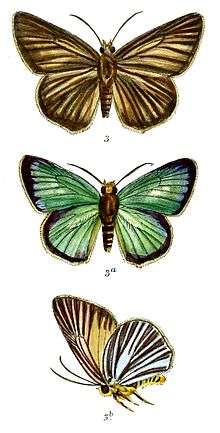Bibasis gomata
| Pale green awlet | |
|---|---|
 | |
| Male (top), female, male underside | |
| Scientific classification | |
| Kingdom: | Animalia |
| Phylum: | Arthropoda |
| Class: | Insecta |
| Order: | Lepidoptera |
| Family: | Hesperiidae |
| Genus: | Bibasis |
| Species: | B. gomata |
| Binomial name | |
| Bibasis gomata (Moore, 1865)[1] | |
| Synonyms | |
|
Ismene gomata Moore, 1865[1] | |
Bibasis gomata, commonly known as the pale green awlet,[2] is a butterfly belonging to the family Hesperiidae. It is found in Northeast India, the Western Ghats and parts of Southeast Asia. The butterfly was reassigned to genus Burara by Vane-Wright and de Jong (2003) and is considered by them to be Burara gomata.[3]
Range
The pale green awlet ranges from India, Myanmar, the Malay Peninsula, the Philippines, and the Indonesian archipelago. In India, the butterfly is found in South India up to North Kanara, and along the Himalayas from Sikkim to Assam and eastwards to Myanmar.[2]
The type locality is Darjeeling in the north of West Bengal.[2]

Status
This species is rare in South India but not rare in the Himalayas.[4]
Description
The butterfly has a wingspan of 50 to 55 mm.[4]
Edward Yerbury Watson (1891) gives a detailed description:[5]
Male. Upperside pale vinaceous brown; both wings with pale brownish yellow streaks longitudinally between the veins. Abdomen blackish brown with yellowish bands. Cilia yellowish. Underside dark brown, with the veins and longitudinal streaks between them greyish green, the brown showing only along each side of the veins; posterior margin of forewing broadly pale vinaceous; exterior margin of both wings defined by a brown line. Third joint of palpi and edge of sides brown, the rest yellow. Thorax, legs and abdomen beneath orange yellow.Female. Expanse 2.3 inches. Upperside very dark glossy bronzygreen, shading off into glossy indigo-blue at the apex and outer margin. Underside with the markings and ground-colour darker than in Sikkim males; forewing with a pale green spot in the second median interspace, with a larger one in the interspace below it, in the male these spots are merged in a large patch of the ochreous ground-colour from the inner margin. The green markings everywhere more restricted and of a darker shade than in the male.
— Watson
Habits
This butterfly is crepuscular.[3]
Host plants
The larva has been recorded on Schefflera lurida, Schefflera octophylla, Trevesia sundaica, Embelia garciniaefolia and Horsfieldia species.[2]
Cited references
- 1 2 Card for Bibasis gomata in LepIndex. Accessed 16 October 2007.
- 1 2 3 4 Markku Savela's website on Lepidoptera Page on Bibasis genus.
- 1 2 Vane-Wright and de Jong (2003) (see TOL web pages on genus Bibasis and genus Burara in the Tree of Life Web Project) state that Bibasis contains just three diurnal species, the crepuscular remainder having been removed to Burara. The species now shifted to Burara are morphologically and behaviorally distinct from Bibasis, within which many authors have formerly included them.
- 1 2 Evans, W.H. (1932). The Identification of Indian Butterflies (2nd ed.). Mumbai, India: Bombay Natural History Society. p. 319, ser no I 2.17.
- ↑ Watson, E. Y. (1891) Hesperiidae indicae.
References
- Evans, W.H. (1932). The Identification of Indian Butterflies (2nd ed.). Mumbai, India: Bombay Natural History Society.
- Watson, E. Y. (1891) Hesperiidae indicae. Vest and Co. Madras.
Online
- Beccaloni, George; Scoble, Malcolm; Kitching, Ian; Simonsen, Thomas; Robinson, Gaden; Pitkin, Brian; Hine, Adrian; Lyal, Chris. "The Global Lepidoptera Names Index (LepIndex)". Natural History Museum, London. Retrieved 2016-10-15.
- Brower, Andrew V. Z. and Warren, Andrew, (2007). Coeliadinae Evans 1937. Version 21 February 2007 (temporary). http://tolweb.org/Coeliadinae/12150/2007.02.21 in The Tree of Life Web Project, http://tolweb.org/
- "Markku Savela's website on Lepidoptera".